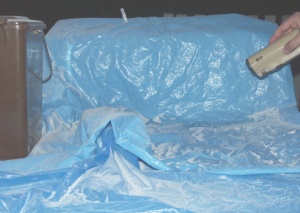Experiment
We orientate the air stream of the hair dryer in wind direction and bring it slowly closer to the flour, until the powder starts to be dispersed in the air.
We observe the dispersion before and behind the barriers.
We can see on the black cardboard on the ground, how far detectable amounts of flour are carried through the air. But we need to consider that particles are also formed and transported which are too fine to be seen or detected.
|
 |
 |
 |
|
3. Flour powder is raised by the hair dryer.
|
|







